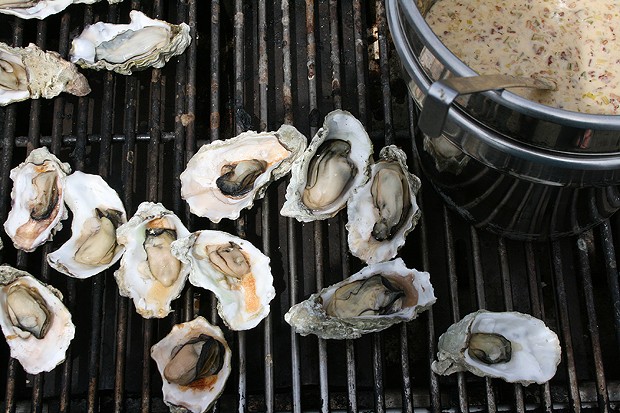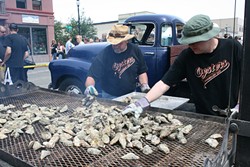Oysters, Beer and Cash
Why Arcata Main Street wants even more money from an $87,000 festival
By Grant Scott-Goforth [email protected] @GScottGoforth[
{
"name": "Top Stories Video Pair",
"insertPoint": "7",
"component": "17087298",
"parentWrapperClass": "fdn-ads-inline-content-block",
"requiredCountToDisplay": "1"
}
]
When organizers of Arcata's Oyster Festival announced they would charge a $10 admission fee this year, people went bonkers. "Elitism!" was the cry du jour. Organizers and supporters pleaded for calm, saying the fee would curtail the festival's rowdiness and right Arcata Main Street's listing finances.
The ruckus has mostly subsided, but "are you going to Oyster Fest this year" is still a conversation-starter that can be overheard on buses, street corners and barstools.
With the festival date nearing, the question remains: Exactly how dire is Main Street's lot, and why does it need more from Oyster Fest?
Main Street Arcata — officially known as Arcata Downtown Business Community Incorporated — formed in 1988 in the heart of the national "Main Street" movement, when cities around the U.S. were looking to revitalize their downtowns and promote local business. "The idea is to keep the downtown area alive — and to keep businesses alive," said Ed Bernard, the owner of Libation wine shop and a member of the Arcata Main Street board of directors. Since then, the nonprofit organization has had its ups and downs, often ending its fiscal year in the red.
Main Street has three main sources of income. It gets money from the city of Arcata — funding that has been declining in recent years. Main Street collects dues from its members — another source that's been shrinking. And then there's Oyster Fest, which struggled for years until Jennifer Koopman took over as executive director in 2008 and turned it into a money-making, oyster-slinging, beer-selling juggernaut.
Last year the festival netted Main Street $87,000 ($136,000 in total income, before festival expenses), down from $89,000 the year before. But the festival wasn't always so profitable. It took losses in 2000 and 2005, and netted no more than $17,000 in any year in between. Since 2007, the year before Koopman began, the festival's profits have risen more than 400 percent from $21,000 up to nearly $90,000.
During the same time that festival proceeds were rising, Main Street's other income sources were falling — giving fundraising events a bigger and bigger role in the organization's health. (In fact, Main Street lost money on festivals more often than not from 1999 through 2005, years when it had a hand the North Country Fair and Godwit Days.) Just four years ago, Oyster Fest brought in half of Main Street's revenue —– now that's up to 85 percent.
But while Oyster Fest is Main Street's biggest and most prominent fundraiser, getting a full grip on the group's finances has been difficult.
Starting on May 1, the Journal left at least a dozen phone messages for Koopman and sent six emails asking her for a breakdown of Oyster Fest costs and revenues, and a look at the operating budget of Main Street. At first she said she needed to talk to board members. Then she had to have a conversation with an accountant. Then she promised a meeting soon. Then she said she was too busy preparing for the festival to go over all those numbers. On the afternoon before publication deadline, Koopman took time to talk with the Journal, though she still didn't provide Main Street's annual budgets.
So for now, the only snapshot the public has comes from some general comments Koopman made, plus yearly Internal Revenue Service 990 forms that Main Street must fill out because it's a charitable organization.
By all accounts, the biggest moneymaker at Oyster Fest is beer.
"We've been really dependent on alcohol sales in the past, and we don't want to be," Koopman said. "If it costs you $10 to get in and you buy one less beer, we're OK with that."
Lost Coast Brewery Sales Director Briar Bush believes that attendees at Oyster Festival consume more beer than those at any festival of its kind in California.
Last year, which he said was the pinnacle of beer sales, drinkers went through 150 kegs. (At 125 cups of beer to a keg, that's 18,750 beers sold. At $6 a pop, that's more than $112,000 — a good chunk of Oyster Fest's $136,000 gross income last year.)
Local breweries don't sell beer directly to the festival — that's done through a distributor. Humboldt Beer Distributors owner Al Cooper said his business supplies local beer to Oyster Fest for the "same price as anyone else."
The festival typically asks brewers to donate to the festival, but Bush — of Lost Coast Brewery — said the amount Oyster Festers drink is far too much for any one brewery to give away. Instead, Lost Coast Brewery and Mad River Brewery are splitting the cost of beer cups as a donation to this year's festival.
Though the Oyster Festival has turned a profit, Koopman says it isn't enough to cover Main Street's rising costs.
"We're always robbing Peter to pay Paul," she said.
Koopman said proceeds from the Oyster Festival help fund everything Main Street does, including Arts! Arcata and other plaza events. The Season of Wonder and Light — Main Street's winter holiday promotion — cost the organization more than $15,000 last year, Koopman said.
"We're just trying to sustain our organization, of course," she said. "Either there's an Oyster Festival or there's not. Without the Oyster Festival you wouldn't be able to do any of those things."
Main Street ended its last fiscal year $585 in the hole, according to its federal tax filing for the period running from July 1, 2011, through June 30, 2012. Overall, its expenses have doubled from $52,000 in 1999 to $106,000 in 2012.
Main Street's biggest single expense is Koopman's salary, which has grown 20 percent since she took over five years ago. The executive director position averaged just under $40,000 a year between 1999 and 2006. It has fluctuated since then, but rose to $48,000 by the 2011-12 fiscal year. Main Street also paid $8,000 in benefits for Koopman's position and $4,000 in payroll taxes.
"She's worth every penny we pay her," Bernard said.
Main Street Board President David Neyra, who owns Humboldt Outfitters, said the board has tried to bump up Koopman's salary as her workload went up. In the past Koopman had part-time workers, student interns and other help, but lately she's been short-handed.
During its last fiscal year, Main Street also spent $7,000 on rent for its Jacoby's Storehouse office, $6,000 on professional fees, and $32,000 on "other expenses," which include insurance, utility bills and other costs. All the while, Main Street started to feel the tightening of its non-fest income. The city awarded Main Street more than $30,000 a year in redevelopment funds between 2008 and 2011 — money that the state gave cities to dole out for community projects. When the state pulled those funds, Arcata's City Council voted in 2011 to give Main Street money from its general fund (lowering the amount it gave to other organizations, including the Chamber of Commerce, the Humboldt County Convention and Visitor Bureau and the Humboldt County Film Commission).
Community Development Director Larry Oetker said other groups took "prorated reductions" to fund Main Street. "They were all proportionally reduced," he said.
The city gave Main Street $18,000 in the 2011-2012 fiscal year, and budgeted the same for this year.
Main Street's member dues have also diminished from an average of $14,000 a year between 1999 and 2007 to $8,600 this year.
"We have a hard time keeping membership,'" Bernard said — but he declined to say why, saying he didn't want to speak for other business owners.
Koopman said she wasn't certain why membership fell, but she had some ideas. The timing syncs up with the national recession, Koopman said, which forced businesses to cut down on expenses.
Former board member Patrick Murphy, who resigned in January, said he thinks a lack of recruiting keeps new businesses from joining Main Street. "A lot of those businesses don't see how Oyster Fest is helping them out," he said, adding Main Street was more caught up in the Oyster Festival than working with downtown businesses. "Even as a board member my business didn't get posted on the website for a year," he said.
Koopman took some of the blame, saying it's an ongoing challenge — and goal — to work with potential and current members, given her workload.
During his time on the board, Murphy said he talked to a business owner who gave up on applying to Main Street after trying several times to visit the office and finding it closed.
"That's frustrating," Koopman said, adding that one of the goals of increasing Main Street's income is to hire more people to staff the office while she's in meetings and tending to other tasks.
Main Street currently has 66 members. According to the organization's application, full members pay $160 a year, while nonprofits and members outside of Main Street's focus area (Sixth to 12th streets, between F and I streets) pay $65 a year. Individuals and families can pay $25 a year to be a "Main Street Supporter" and Arts! Arcata venues pay an additional $120 a year.
For Bernard, the $160 yearly membership fee is well worth the customers who Arts! Arcata, Oyster Fest and holiday events bring to his shop. "It's a matter of people being here. If people don't show up to the plaza, I'm not going to sell anything."
Other business owners clearly disagree — or at least haven't found enough value from Main Street to keep on paying membership fees — but few have been willing to talk about the organization for the record. Rookery Books owner Tom Clapp said he pulled out of the group after a personal dispute with a board member over the volume of music at plaza events. He said his complaints have since been addressed and Koopman is doing an "excellent job" — but he hasn't considered rejoining.
Board President Neyra said the group has been seeking new board members, and the changes in Oyster Fest have sparked some interest. "People don't have to question what we're doing," he said. "People can come to a board meeting and become a board member" — once they've joined the organization, that is.
Arcata Main Street says it has ambitions beyond throwing Oyster Fest year after year. When the group announced its intention to charge admission for the festival, Koopman said in a press release that it was introducing a scholarship for graduating Arcata High School students and funding a grant for Humboldt Bay aquaculture. The amount of the scholarship and grant will be decided when the board sees how Oyster Fest fares this year.
Koopman and board members Neyra and Bernard declined to give projected revenues for this year's festival, but said they were confident this year's festival will be a success. Bernard wouldn't elaborate on how board members came to decide on a $10 entrance fee — other than the hope that it would increase income without alienating too many attendees.
They'll get their answer next week.
Speaking of Oyster Festival, Arcata Main Street
-

Music Tonight: Sunday, July 16
Jul 16, 2023 -

A Second Amateur Win at Oyster Fest
Jun 15, 2023 -

Photos: Dia de los Muertos Celebration
Nov 2, 2022 - More »
Comments (6)
Showing 1-6 of 6
more from the author
-
Flamin' Hot's Stale Corporate Propaganda
- Jun 15, 2023
-
Hell is Visiting Other People
- Sep 22, 2022
-
The Bear Roars
- Aug 18, 2022
- More »
Latest in News
Readers also liked…
-
Through Mark Larson's Lens
A local photographer's favorite images of 2022 in Humboldt
- Jan 5, 2023
-
'To Celebrate Our Sovereignty'
Yurok Tribe to host gathering honoring 'ultimate river warrior' on the anniversary of the U.S. Supreme Court ruling that changed everything
- Jun 8, 2023


































